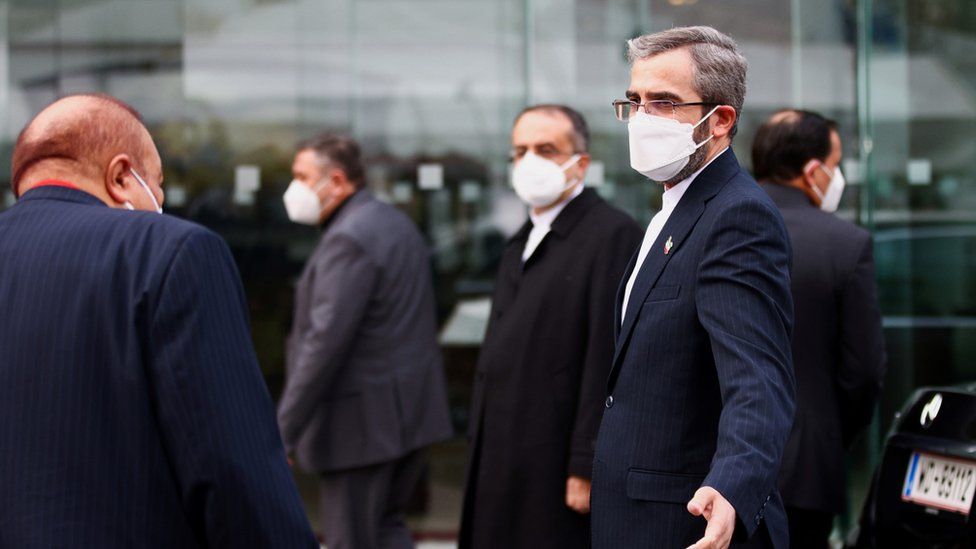Thursday, December 2
Mr. Freedom
 SOURCE,GETTY IMAGES
SOURCE,GETTY IMAGESOutspoken professional basketball player Enes Kanter has legally changed his name to Enes Kanter Freedom to celebrate becoming a US citizen.The Swiss-born, Turkish-raised Mr Kanter, 29, tweeted a video of his citizenship ceremony on Monday. He recited the oath using his new name.
He has repeatedly condemned human rights violations in China and Turkey.The NBA star has said his Turkish passport was revoked by authorities in 2017.In an interview with CNN, Mr Kanter, who plays with the Boston Celtics, said the name change will reflect his "fight" for freedom throughout his life.
"Here [in the US] there is freedom of speech, freedom of religion, freedom of expression, freedom of the press," he said. "I didn't have any of those with Turkey."In his remarks, Mr Kanter said that "freedom is the greatest thing a human being can have"."That's why I wanted to make that word a part of me, and carry it wherever I go," he added.
Mr Kanter's manager told the AP news agency that the name change would take place at the same time as his naturalisation ceremony on Monday.During the ceremony, the judge addressed him by his new name, and he himself used it to swear his oath of allegiance to the United States.
He waved a miniature flag in the air after the oath and said "Freedom - that's it" while signing his naturalisation documentThe name 'Freedom' will be on his jersey when the Celtics face off against the Philadelphia 76ers later this week. Mr Kanter has said his team-mates already call him by that name. READ MORE...
Labels:
AP News Agency,
BBC,
Cletics,
CNN,
Mr. Freedom,
NBA,
Switzerland,
Turkey,
US Citizen
Female Prime Minister Returns
 SOURCE,REUTERS...MPs voted again to elect Swedish Social Democratic Party leader Magdalena Andersson on Monday
SOURCE,REUTERS...MPs voted again to elect Swedish Social Democratic Party leader Magdalena Andersson on MondaySweden's first female prime minister has been reappointed to the top job after political turmoil forced her to resign within hours of taking the post last week.
MPs backed Social Democratic Party leader Magdalena Andersson by a narrow margin in a new vote on Monday.
She will attempt to lead a one-party government until an election in September next year.
She stood down as PM last Wednesday after her coalition collapsed.
Just hours earlier, Ms Andersson had been elected as Sweden's first female prime minister by a single vote in parliament.
But the 54-year-old economist's plan for forming a new coalition government with the Green Party was thrown into disarray when her budget proposal failed to pass.
Sweden's first female PM resigns hours after appointment
Instead, parliament voted for a budget drawn up by a group of opposition parties, including the far-right Sweden Democrats.
The Green Party said it would not accept a budget drafted by the far-right and walked away from the government, leading to its demise.
By convention, the prime minister in Sweden is expected to resign if a coalition party leaves government. READ MORE...
Wednesday, December 1
Pre-School Test
I already knew I was dumber than the fifth graders...
But now it's thepreschoolers!! A PRE-SCHOOL TEST FOR YOU.
Which Way is the bus below traveling? To the left or to the right?
Can't make up your mind?
Look carefully at the picture again. Still don't know?
Pre-schoolers all over the United States
were shown this picture and asked the same question.
92% of the preschoolers gave this answer.
"The bus is traveling to the left."
When asked, "Why do you think the bus is traveling to the left?"
They answered:
"Because you can't see the door to get on the bus."
How do you feel now???
I know, me too.
Have a nice day!
Personally, I think the reason why us older people answer incorrectly is WE WALKED TO SCHOOL !
Underwater Kites
 SOURCE,MINESTO...The energy-generating kites "fly" under the water, tethered to the seabed
SOURCE,MINESTO...The energy-generating kites "fly" under the water, tethered to the seabedA pair of sleek, winged machines are "flying" - or at least swimming - beneath the dark waters of the Faroe Islands in the North Atlantic.
Known as "sea dragons" or "tidal kites", they look like aircraft, but these are in fact high-tech tidal turbines, generating electricity from the power of the ocean.
The two kites - with a five-metre (16ft) wingspan - move underwater in a figure-of-eight pattern, absorbing energy from the running tide. They are tethered to the fjord seabed by 40-metre metal cables.
Their movement is generated by the lift exerted by the water flow - just as a plane flies by the force of air flowing over its wings.
Other forms of tidal power use technology similar to terrestrial wind turbines but the kites are something different.
The moving "flight path" allows the kite to sweep a larger area at a speed several times greater than that of the underwater current. This, in turn, enables the machines to amplify the amount of energy generated by the water alone. READ MORE...
Calling From Boats

A local support group gives out breakfast at a migrant camp west of Dunkirk
Just outside Grande-Synthe to the west of Dunkirk lies the encampment. Scores of tents straddle a railway track and curve around by a canal, wedged in between a main road and an industrial estate.
People have come from all over the world to be here - searching for a way to cross the Channel and start a new life in the UK.
There is a whole community of people whose lives are bound up with these migrants on their doorstep.
Eve-Marie Dubiez, a local to the area, is one of half a dozen volunteers doling out sandwiches and hot chocolate on Friday morning. Her group provides breakfast here twice a week, armed also with rain ponchos, socks, and sometimes shoes, when they can get them.
She is confident there will be a solution to the migrant crisis in northern France. "But these are the ones paying the price for the moment," she says, gesturing to the people collecting food from her colleagues.
Eve-Marie has spent the last 15 years working in camps like these. She says police regularly move people on, demolishing camps or pushing people further along the coast. "Everybody wants to get rid of them one way or the other," she says. READ MORE..
Iran Nuclear Deal
 IMAGE SOURCE,REUTERSImage caption,
IMAGE SOURCE,REUTERSImage caption,Iran's chief negotiator Ali Bagheri Kani says the West "needs to pay a price" for its actions
Critical talks with Iran to prevent the collapse of a nuclear deal have resumed in Vienna after a five-month pause.
Officials are discussing the possible return of the US to the 2015 accord, which limited Iran's nuclear activities in return for the lifting of sanctions.
Iran has violated key commitments since then-President Donald Trump pulled out in 2018 and reinstated US sanctions.
Joe Biden is willing to lift them if Iran reverses the breaches. But Iran wants the US to make the first move.
Western diplomats have warned that time is running out to negotiate a solution because of the significant advances Iran has made in its uranium enrichment programme, which is a possible pathway to a nuclear bomb.
Iran insists that its nuclear programme is entirely peaceful.
ANALYSIS: Could Iran talks succeed?
ANALYSIS: Threat of Israeli strike on Iran nuclear sites grows
BACKGROUND: Iran nuclear deal: What it all means
Diplomats from Iran and the five countries still party to what is known formally as the Joint Comprehensive Plan of Action (JCPOA) - China, France, Germany, Russia and the UK - met at a hotel in the Austrian capital on Monday afternoon, with US representatives participating indirectly. READ MORE...
Tuesday, November 30
5 Educational Trends for 2022
1. Technological trends in teaching and learning
The explosion of technology over the past two decades has not left the education sector behind. Computers and the internet have changed how students can not only access information but even classes themselves. By the fall of 2017, there were over 6.5 million students enrolled in some distance learning opportunity at a degree-granting postsecondary institution.
The growth of technological capabilities means that a variety of media and learning-support tools now exist to help students receive a high-quality education through the Internet.
This trend presents a number of benefits and drawbacks for teachers and institutions who want to continue to offer their students the rigorous education they need to thrive.
Technology, for example, may not encourage students to learn soft skills. They might not have the built-in opportunities to engage with their fellow students, the way they might in traditional-style classrooms. For example, opportunities for leadership on group projects will not occur as organically as they once did.
The online platform may also force teachers to change how they teach. They might find it challenging to change how they approach lesson plans to ensure that the students remain engaged even while they cannot see the instructor in person.
Fortunately, the advent of the online classroom and technology-infused instruction also offers a wealth of opportunities for instructors and their institutions. Many teachers notice immediately the greater flexibility they can offer in their learning schedule. Platforms may offer opportunities for students to watch lectures live or recorded versions later. Teachers can appreciate this benefit for students.
The online nature of these courses may also enhance the ability of teachers to offer accommodations for different styles of learning. Advanced students may receive additional learning resources and challenges to encourage them to go deeper into the material without interrupting the flow of the rest of the class.
Learning management systems can also make it easier for teachers to track how their students progress through the course. They can see how their students have engaged with the broadcast and recorded classes, therefore, they have a more efficient tracking system that allows them to provide more timely coaching as needed.
2. Soft skills training: a major trend in higher education
According to the Future of Jobs report, some of the most important skills in the workplace include critical thinking, problem-solving, people management, and creativity. Employers want to see emerging professionals who understand how to make hard decisions and showcase their leadership abilities.
In an effort to prepare students for their future careers, schools must have the training in place to help students nurture and grow in these skill areas.
However, as already discussed, the simultaneous trend towards online learning does make this a challenge for many teachers. These educators will need to find a way to balance the screen time involved in their class with the importance of encouraging students to work together face-to-face to nurture soft skill development.
The institutions that uncover quality formulas for encouraging the development of these skills, however, will find that this trend offers them a number of opportunities for growth. Specifically, these institutions will find themselves with a competitive advantage within higher education. Their students will be more employable, which will improve their alumni success rates, creating a virtuous circle as future students look for schools with strong alumni success rates.
3. Student trend: decreasing attention spans
As the prevalence of technology has grown, attention spans have also changed for students. A study conducted by Microsoft looked at the attention spans overall between 2000, which was the dawn of the mobile revolution, and 2015. They found that attention spans decreased by an incredible 4 seconds-- from 12 seconds to 8. This drop has largely been blamed on the nature of technology and the constant stimulation it offers viewers.
The changes in attention span can also be used as an excellent way to differentiate between the different generations. Millennials, for example, who have largely grown up with this technology at their fingertips, have distinct characteristics from the Gen X and Boomers who came before them.
Most notably, Millennials report that when content is highly engaging, they have the potential to pay attention for longer periods than past generations. However, when that content does not engage them, they become among the first to tune out the speaker.
To keep the attention of Millennials, the content presented to them must have excellent visuals and dialogue along with an interesting storyline that will hold their attention. This younger group cares more about the narrative and the visual nature of the content that interests them than other age groups.
This difference in attention can also be seen in the behavior of Millennials compared to other age groups. Among young adults, 77 percent report that they will reach for a phone when they have nothing else to occupy their attention. For those over the age of 65, however, only 10 percent report the same.
This change in attention trends also has a tremendous impact on how instructors adjust their classes and keep students engaged with the material. Teachers need to find ways to design classes that will catch the attention of their students, many of whom will fall into this Millennial generation, and adapt the course delivery method and pace. Their course design will need to remember the importance of a strong narrative and visuals.
However, do not forget that when students have material in front of them that is highly visual and engaging, they have excellent potential to pay attention. These modern students want to be challenged, and they value interaction. For teachers who learn how to engage with these students, they can present rewarding opportunities for classroom growth. TO FIND OUT ABOUT THE LAST TWO, CLICK HERE...
The explosion of technology over the past two decades has not left the education sector behind. Computers and the internet have changed how students can not only access information but even classes themselves. By the fall of 2017, there were over 6.5 million students enrolled in some distance learning opportunity at a degree-granting postsecondary institution.
The growth of technological capabilities means that a variety of media and learning-support tools now exist to help students receive a high-quality education through the Internet.
This trend presents a number of benefits and drawbacks for teachers and institutions who want to continue to offer their students the rigorous education they need to thrive.
Technology, for example, may not encourage students to learn soft skills. They might not have the built-in opportunities to engage with their fellow students, the way they might in traditional-style classrooms. For example, opportunities for leadership on group projects will not occur as organically as they once did.
The online platform may also force teachers to change how they teach. They might find it challenging to change how they approach lesson plans to ensure that the students remain engaged even while they cannot see the instructor in person.
Fortunately, the advent of the online classroom and technology-infused instruction also offers a wealth of opportunities for instructors and their institutions. Many teachers notice immediately the greater flexibility they can offer in their learning schedule. Platforms may offer opportunities for students to watch lectures live or recorded versions later. Teachers can appreciate this benefit for students.
The online nature of these courses may also enhance the ability of teachers to offer accommodations for different styles of learning. Advanced students may receive additional learning resources and challenges to encourage them to go deeper into the material without interrupting the flow of the rest of the class.
Learning management systems can also make it easier for teachers to track how their students progress through the course. They can see how their students have engaged with the broadcast and recorded classes, therefore, they have a more efficient tracking system that allows them to provide more timely coaching as needed.
2. Soft skills training: a major trend in higher education
According to the Future of Jobs report, some of the most important skills in the workplace include critical thinking, problem-solving, people management, and creativity. Employers want to see emerging professionals who understand how to make hard decisions and showcase their leadership abilities.
In an effort to prepare students for their future careers, schools must have the training in place to help students nurture and grow in these skill areas.
However, as already discussed, the simultaneous trend towards online learning does make this a challenge for many teachers. These educators will need to find a way to balance the screen time involved in their class with the importance of encouraging students to work together face-to-face to nurture soft skill development.
The institutions that uncover quality formulas for encouraging the development of these skills, however, will find that this trend offers them a number of opportunities for growth. Specifically, these institutions will find themselves with a competitive advantage within higher education. Their students will be more employable, which will improve their alumni success rates, creating a virtuous circle as future students look for schools with strong alumni success rates.
3. Student trend: decreasing attention spans
As the prevalence of technology has grown, attention spans have also changed for students. A study conducted by Microsoft looked at the attention spans overall between 2000, which was the dawn of the mobile revolution, and 2015. They found that attention spans decreased by an incredible 4 seconds-- from 12 seconds to 8. This drop has largely been blamed on the nature of technology and the constant stimulation it offers viewers.
The changes in attention span can also be used as an excellent way to differentiate between the different generations. Millennials, for example, who have largely grown up with this technology at their fingertips, have distinct characteristics from the Gen X and Boomers who came before them.
Most notably, Millennials report that when content is highly engaging, they have the potential to pay attention for longer periods than past generations. However, when that content does not engage them, they become among the first to tune out the speaker.
To keep the attention of Millennials, the content presented to them must have excellent visuals and dialogue along with an interesting storyline that will hold their attention. This younger group cares more about the narrative and the visual nature of the content that interests them than other age groups.
This difference in attention can also be seen in the behavior of Millennials compared to other age groups. Among young adults, 77 percent report that they will reach for a phone when they have nothing else to occupy their attention. For those over the age of 65, however, only 10 percent report the same.
This change in attention trends also has a tremendous impact on how instructors adjust their classes and keep students engaged with the material. Teachers need to find ways to design classes that will catch the attention of their students, many of whom will fall into this Millennial generation, and adapt the course delivery method and pace. Their course design will need to remember the importance of a strong narrative and visuals.
However, do not forget that when students have material in front of them that is highly visual and engaging, they have excellent potential to pay attention. These modern students want to be challenged, and they value interaction. For teachers who learn how to engage with these students, they can present rewarding opportunities for classroom growth. TO FIND OUT ABOUT THE LAST TWO, CLICK HERE...
Subscribe to:
Posts (Atom)
















